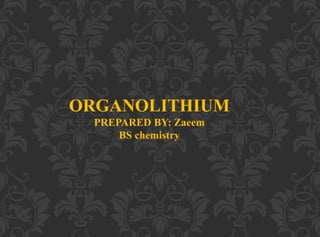
Organolithium compounds and their preparation.pptx
- 1. ORGANOLITHIUM PREPARED BY: Zaeem BS chemistry
- 2. Objectives • To understand about structure of Organolithium compounds • To understand about reactivity of Organolithium compounds
- 3. ORGANOLITHIUM COMPOUNDS ● The organolithium compounds are characterized by C-Li and are important in Organic synthesis. ● Although ,Organolithium compounds show similar reactivity as grignard reagents, they are more reactive than Grignard reagents. ● Lithium is less electronegative than carbon , and the C-Li bond is polarized (C ¯-Li˖) as in Grignard regents. ● The Organolithium behaves both as Nucleophile and a base.
- 4. PREPARATION : 1) FROM ALKYL OR ARYL HALIDES: The reaction of lithium metal at low temperature with an alkyl or aryl halide in a Hydrocarbon solvent in inert atmosphere ( Nitrogen or Argon) gives an Alkyl Lithium. ● The yield of alkyl-lithium is very low if pure lithium is used. ● It is believed that Lithium must contain at least 0.02% of sodium for the reaction to proceed smoothly. ● In above reaction ,the reactivity of halides is : RI> RBr> RCl ORGANOLITHIUM COMPOUNDS
- 5. 2) BY HALOGEN-METAL EXCHANGE METHOD: This method is useful for the preparation of those Organolithium reagents That can not be obtained from alkyl halide and metal directly. In this method , an organic halides is treated with alkyl-Lithiums. ● This method is best suited for the preparation of Aryl-lithium derivatives. ● Thus , phenyl-lithium is prepared by treating bromo-benzene with n-butyl-lithium. 6 ORGANOLITHIUM COMPOUNDS
- 6. 3) BY METALATION: Compounds containing acidic hydrogen can be easily converted into Organolithium compounds by treatment with a suitable Organolithium compound. 7 ORGANOLITHIUM COMPOUNDS
- 7. PROPERTIES : ● Organolithium are very reactive ,powerful nucleophiles and strong bases. ● These find numerous application in organic synthesis. ● These are better than the Grignard reagents. ORGANOLITHIUM COMPOUNDS
- 8. CHEMICAL REACTIONS 1) REACTIONS WITH COMPOUNDS CONTAINING ACTIVE HYDROGEN: The organolithium react with substrates having active hydrogen such as Water alcohols ,amines (primary and secondary )and carboxylic acids to give the corresponding hydrocarbons in quantitative yields. In this respect ,the organolithium reagents resembles Grignard reagents. ORGANOLITHIUM COMPOUNDS
- 9. 2) REACTION WITH CARBONYL COMPOUNDS : ● As in the case of Grignard reagents , the organolithiun reagents react with aldehydes to form secondary alcohols and with ketones to form tertiary alcohols. ● Primary alcohols are obtained by treatment with formaldehyde. ● The yields of the alcohols ,in case of Organolithium is better that in case of Grignard reagents. 10 ORGANOLITHIUM COMPOUNDS
- 10. 11 2) REACTION WITH CARBONYL COMPOUNDS : ORGANOLITHIUM COMPOUNDS
- 11. ● It has been stated that Grignard reagents (e.g.CH3MgBr) do not react with hindered ketones. ● However , the Organolithium reagents are less susceptible to steric factors and react with hindered ketones giving the corresponding tertiary alcohols. ● Organolithium reagents also react with esters to form the tertiary alcohols. ● The ketones that are initial products of reactions are more reactive than esters, thus react further with organolithium reagents to yield alcohols. 12 ORGANOLITHIUM COMPOUNDS 2) REACTION WITH CARBONYL COMPOUNDS :
- 12. 3) REACTION WITH ALKYL CYANIDE: ● Like Grignard reagents, the organolithium reagents also react with Alkyl cyanides to give imine salts. ● When the reactions is worked up with water, protonation first gives the imine , which on acid hydrolysis generates the ketone. 13 ORGANOLITHIUM COMPOUNDS
- 13. 4) REACTION WITH EPOXIDES: ● The epoxides react with organolithium reagents to give primary alcohols( as in case of Grignard reagents). 14 ORGANOLITHIUM COMPOUNDS
- 14. 5) REACTION WITH CARBON DIOXIDE: ● It is known that Grignard reagents on reaction with carbon dioxide give carboxylic acids. However , in case of organolithium reagents, the formed carboxylate anion reacts with a second molecule of the reagent to give a ketone. ● This method finds applications in the conversion of carboxylic acids into ketones. 15 ORGANOLITHIUM COMPOUNDS
- 15. 6) REACTION WITH ALKENES: • Organolithium reagents ( being more reactive than Grignard reagents) react with alkenes to give alkyl-lithium, which reacts with a second molecule of the alkene to give the corresponding alkyl-lithium. • This process continues depending on the relative amount of the alkene. 16 ORGANOLITHIUM COMPOUNDS
- 16. 7) ELECTROPHILIC DISPLACEMENT: The reaction of an organic halide with an Organometallic compound is known as Metal-halogen exchange reaction. ● This is an example of electrophilic displacement and finds use in the synthesis of vinyl lithium from vinyl bromide. ● This method is useful for the preparation of phenyl lithium. 17 ORGANOLITHIUM COMPOUNDS
- 17. 8) NUCLEOPHILIC DISPLACEMENT: The halogen of the alkyl halides can be substituted with the alkyl group of the organolithium reagent to give Hydrocarbons. ● This reaction takes place by SN2 mechanism as in the case of Wurtz reaction. 18 ORGANOLITHIUM COMPOUNDS
- 18. ● The reaction of aryl halides with phenyl lithium take place via an elimination- addition pathway and not via usual aromatic substitution reactions. ● In this reaction, phenyl lithium acts as strong base to abstract the O-hydrogen generating a carbanion and also acts as nucleophile in addition to naphthyene. 8) NUCLEOPHILIC DISPLACEMENT: ORGANOLITHIUM COMPOUNDS
- 19. 9)REACTION WITH α AND β –UNSATURATED CARBONYL COMPOUNDS: ● It has been stated that Grignard reagents react with α and β-unsaturated carbonyl compound giving 1,2- or 1,4-addition product depending on the structure of the c carbonyl compound. ● The main reason is steric hinderance. ● The organolithium reagents on the other hand give exclusively 1,2-addition Products. 20 ORGANOLITHIUM COMPOUNDS
- 20. ● Exclusive formation of 1,4-addition product , can however , be achieved by use of Lithium dialkylcuprates 21 ORGANOLITHIUM COMPOUNDS 9)REACTION WITH α AND β –UNSATURATED CARBONYL COMPOUNDS: